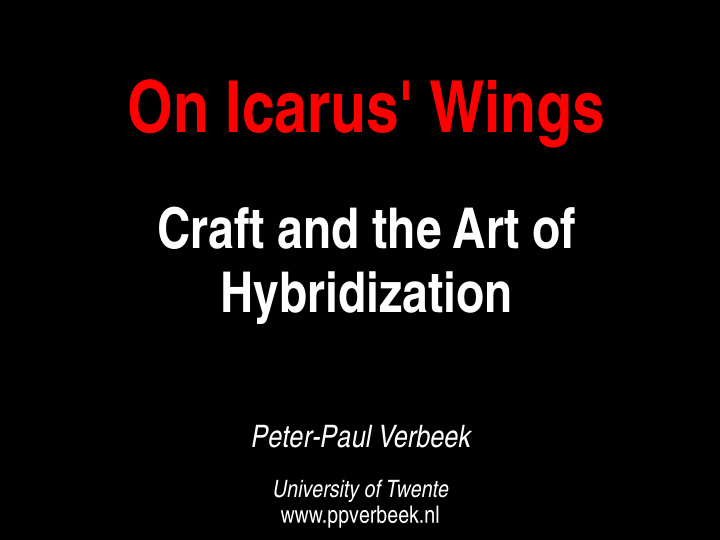



On Icarus' Wings Craft and the Art of Hybridization Peter-Paul Verbeek University of Twente www.ppverbeek.nl
Outline 1. Interaction Design: human-technology relations 2. Mediation Theory: understanding hybridity 3. Hubris and Hybris: the limits of humanity 4. Ascetic Design: crafting the mediated self
Outline 1. Interaction Design: human-technology relations 2. Mediation Theory: understanding hybridity 3. Hubris and Hybris: the limits of humanity 4. Ascetic Design: crafting the mediated self
Interaction Design
Interaction Design
Google Glass
Conceptualizing human- technology interactions • Extension: instrumentality – intentional humans, neutral things • Dialectics: tension – oppression, externalization • Hybridity: mutual constitution – boundary blurring
Neutrality • Joe Pitt: Instrumentalism – human intentions, instrumental things • B.J. Fogg: Persuasive Technology – transparent persuasions • Basic model: – things as ‘tools’ or ‘enablers’ – neutral extensions of human possibilities
Dialectics • Philosophical anthropology: – Ernst Kapp: organ projections – Hermann Schmid: externalizations – Arnold Gehlen: relations to the organic • Phenomenology: – alienation from self / reality • Applied ethics: – technological risks basic model: tension
Hybridity • basic model: > interwoven character of humans and things > from interaction to 'intra-action' (Barad) • beyond the split between ‘subject’ and ‘object’: – symmetrical: actor-network theory: associations – asymmetrical: postphenomenology: mediations
Interaction Design
Designing Things as Crafting Subjects: • craft / technè: art and technology • art: specific 'interaction': 'earth' versus 'world' • design: - technological crafting of human-technology relations - helping to reveal not only 'things' but also 'humans'
Outline 1. Interaction Design: human-technology relations 2. Mediation Theory: understanding hybridity 3. Hubris and Hybris: the limits of humanity 4. Ascetic Design: crafting the mediated self
Mediation Theory Technologies mediate the relation between humans and their environment: human - world becomes: human - technology - world
Human-technology relations (Don Ihde): • embodiment relation (human - technology) → world • hermeneutic relation human → (technology - world) • alterity relation human → technology (world) • background relation human (technology / world)
Postphenomenology perception / experience human technology world action / practices
New configurations (1): • Fusion: (human / technology) → world • Use: (human - technology) → world human → (technology - world) human → technology (world) human (technology / world) • Immersion: human ↔ (technology / world)
New configurations (2): • Lab-on-a-chip: alteration human → technology → human • Glass: augmentation (human - technology) → world ' → ( technology - world )
Toward a theory of mediation • Expanding postphenomenology: while opening the black box of technology, the black box of the human remained closed • Corporality: ‘somatechnology’ • Appropriation: domestication, subjectivation
Appropriation • Foucault: subjectivation (Steven Dorrestijn) • Conversation Analysis – ' phenomenological' approach – how do agents make entities ‘real’? • ‘techno-hermeneutics’ investigating human-technology relations ‘from within’
Toward a mediation theory • Three questions of Kant: • Know? —> Epistemology • Do? —> Ethics • Hope? —> Metaphysics • One more turn after the material turn: • mediation and appropriation
Outline 1. Interaction Design: human-technology relations 2. Mediation Theory: understanding hybridity 3. Hubris and Hybris: the limits of humanity 4. Ascetic Design: crafting the mediated self
Humans and Technologies • hybrids: mixtures • hubris: going too far
Humans and Technologies • hybrids: mixtures • hubris: going too far
Sigmund Freud
Do Artifacts human Have Morality? Artifacts and Morality: • experience – moral instrumentalism – artificial agency – moral mediation technology Technological Mediation: • • mediation of praxis praxis and experience • technologies help to shape moral actions and decisions world
Outline 1. Interaction Design: human-technology relations 2. Mediation Theory: understanding hybridity 3. Hubris and Hybris: the limits of humanity 4. Ascetic Design: crafting the mediated self
Ascesis and technology • Michel Foucault: - technology as power • dialectic reading: - Panopticon - oppression and liberation • hermeneutic reading: - technologies of the self - ascesis as 'subjectivation'
Technologies of the self: ethics as subjectivation • ethical substance – mediated existence • mode of subjection: – technological mediations • self practices: – understanding, appropriating and designing technological mediations • teleology: – what hybrids do we want to be?
Ethics from Within • from ’yes’ or ’no’ to 'how?' • from 'assessment' to ’accompaniment’ • 'ascetic design and use' as 'crafting the mediated self'
The ethics of design: materializing morality 1. Anticipating mediations 2. Assessing mediations 3. Designing mediations
Anticipating Mediations: sources of mediation designer (delegation) user mediation (appropriation) thing (emergence)
Assessing Mediations • Ethics from within: • conversation analysis • ethical theory • Making available implicit morality for explicit reflection
Designing Mediations Types of influences (Tromp, Hekkert, and Verbeek)
Example: nudging • Nudging: the ultimate solution? - ‘liberal paternalism’ - ‘transparent persuasions’ • Liberalism: - ‘the blackmail of autonomy’ - nudges and mediations are inevitable • Ascetic design: - taking the mediated self as a starting point - designing room for 'subjectivation'
Design as Crafting Hybrids • Approaching interaction as intra-action … • … shows that designing things is designing humans … • … involving technological mediation and appropriation … • … asking for ascetic design.
Recommend
More recommend